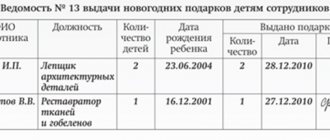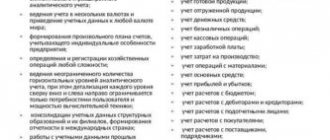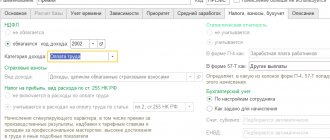Features of construction as a type of business and their impact on accounting
All enterprises in the Russian Federation use uniform accounting standards, but taking into account industry specifics. The main regulatory act that reflects the features of accounting in construction is PBU 2/2008 “Accounting for construction contracts.”
The start and end dates of construction work often fall in different periods. Therefore, the results are reflected in accounting “as soon as they are ready.”
In the general case, accounting must be kept separately for each object for which there is a separate estimate or project. Even if a single contract has been concluded for the entire complex, consisting of several objects, accounting is often carried out separately for each of them. To do this, the following conditions must be met:
- income and expenses can be distinguished for an object;
- there is separate technical documentation for the object
But the opposite situation is also possible, when several contracts are concluded for the construction of one complex facility. From an accounting point of view, they can be considered as a single contract if:
- they relate to one object for which, according to the accounting policy, uniform standards are established;
- work under contracts is performed simultaneously or within a sequential cycle.
Another peculiarity of the construction industry is that facilities owned by one company may be located in different regions. Therefore, branches are often opened at the location of construction sites. The parent enterprise is obliged to report the opening of a branch to the tax authorities at its location within a month, and about the closure - within three days (Clause 2 of Article 23 of the Tax Code of the Russian Federation).
If branches are created within the structure of the organization, a number of issues related to the organization of accounting should be resolved:
- determine the features of accounting in separate divisions;
- determine the list of persons responsible for the timely preparation of the “primary report” according to the approved document flow schedule;
- determine the timing of the transfer of documentation to the parent company for timely reflection in accounting.
What are the specifics of accounting in construction?
Features of accounting in construction are related to the specifics of its activities. Thus, accounting in construction for beginners requires paying attention to, among other things:
- individual characteristics of each construction project;
- territorial fragmentation of construction projects;
- natural specifics of construction (climatic, soil, seasonal and other conditions leading to additional and specific work and (or) costs);
- the need for lengthy preparatory work (development of projects, obtaining permits, etc.);
- variety of types of construction and installation works (CEM);
- multi-stage mutual settlements between construction subjects;
- other nuances.
Despite the specificity of accounting in construction , it is based on generally accepted principles and standard accounts. At the same time, builders:
- specific primary construction materials are used (acts, journals, estimates, certificates, etc.);
- a detailed object-by-object analytics is formed;
- there is often a need to register (deregister) separate divisions, which affects the nuances of taxation and accounting for housing construction ;
- difficulties arise when conducting an inventory (related to the specifics of the materials used, the fragmentation of warehouses and facilities, etc.);
- due to the presence of specific construction expenses, there is a need to develop special accounting algorithms for accounting for certain types of expenses (uniform distribution of costs over time, the possibility of one-time inclusion in expenses, nuances of re-presentation of expenses, compensation, etc.);
- There are other accounting features.
We will talk about specific construction costs and the accounting entries used in this case in the next section.
Contractor's expenses before construction starts
Even before signing the contract, the construction company incurs preliminary costs, which must be reflected in account 97 “Future expenses” (FPR). This could be, for example, the costs of participating in a tender or paying for a bank guarantee.
DT 97 – KT 76 – costs incurred are taken into account as RBP
DT 20 – KT 97 – RBP included in cost after the start of main work
Insurance costs can also be reported as BPO, as shown above. However, another option is also possible. The amount paid to the insurer can be taken into account as an advance, and then the insurance costs can be written off gradually as the period expires. Most often, the insurance amounts are distributed in equal shares over the entire construction period.
DT 76 – CT 51 – advance payment from the insurance company is transferred
DT 20 – KT 76 – insurance payments are expensed
An insurance contract can be concluded for several objects, the construction of which is carried out under one contract. In this case, the method of dividing costs between objects must be reflected in the accounting policy. For example, in proportion to the cost of work for each object, but it is possible to use other criteria.
Accounting for capital construction costs
Based on the documentation on the acceptance of the object into operation, an Act on the acceptance and transfer of the building (structure) is drawn up (form No. OS-1a). On the basis of this act, objects arrive according to D account 01.
Carrying out construction and installation work for own consumption is subject to VAT of 18% (Article 146 of the Tax Code of the Russian Federation). VAT on the cost of construction and installation work is calculated at the end of each tax period. The VAT amount is calculated at a rate of 18% of the cost of construction and installation work (OD invoice 08 multiplied by 18%).
VAT on construction and installation work is deductible in the same quarter. The VAT amount is deductible if the following conditions are met:
1) The object is intended for carrying out transactions subject to VAT
2) The cost of the constructed facility will be included in expenses for income tax purposes
| Construction materials have been capitalized | ||
| VAT | ||
| VAT on materials has been offset | ||
| Construction materials written off | 08-3 | |
| Equipment written off for installation | 08-3 | |
| Salary has been accrued, insurance contributions have been deducted to extra-budgetary funds | 08-3 | 70;69 |
| Depreciation accrued on construction equipment | 08-3 | |
| The costs of operating your own construction machines and mechanisms are reflected | 08-3 | |
| At the end of the reporting period, VAT is charged on the cost of construction and installation work performed using economic methods | ||
| Tax deduction for accrued VAT is reflected | ||
| VAT on construction and installation work has been transferred to the budget | ||
| After completion of construction and state registration, the facility was put into operation | 08-3 |
5. Cost accounting for the formation of the main herd
This group of capital investments includes the following expenses:
a) For raising your own young stock for transfer to the main herd (accounted for in subaccount 08-6)
b) For the purchase of young and adult animals from third-party organizations (accounted for in subaccount 08-7)
When transferring animals to the main herd, an Animal Transfer Certificate is filled out.
| Young animals were transferred to the main herd | 08-6 |
| Animals are included in fixed assets | 08-6 |
| At the end of the year, after calculating the actual cost of animals transferred to the main herd, the difference between the planned cost and the actual cost is written off using an additional entry or the “red reversal” method. | 08-6 |
| At the same time, the amount of registered animals is adjusted by the same amount. | 08-6 |
When purchasing adult animals, the costs of their acquisition
reflected:
| Animals of the main herd were received from breeding farms of other legal entities and individuals | ||
| Delivery costs: a) third-party organizations b) own transport | 08-7 08-7 | 60 (76) |
| Animals are included in fixed assets | 08-7 |
For each subaccount, costs are recorded on separate analytical accounts in accordance with the types of animals (cattle, pigs, sheep, horses, etc.)
6. Cost accounting for planting and growing perennial plantings
In agricultural organizations, a separate group of capital investments consists of the costs of planting and growing perennial plantings, which are subsequently included in fixed assets (orchards, berry fields, vineyards, hop fields, shelterbelts.
The costs of growing perennial plantings are reflected in D subaccount 08-8 in the context of the following cost items:
a) Material costs (seeds and planting material, mineral and organic fertilizers, plant protection products, etc.) D08-8 K10
b) Remuneration D 08-8 K70
c) Insurance contributions to extra-budgetary funds D08-8 K69
d) Maintenance of fixed assets D08 K02
e) Services for auxiliary production D08 K23
f) Services of third parties D08 K60
The basis for accounting for these items are primary documents: labor and work performed accounting sheets, working time sheets, limit cards, invoices, seed and planting material consumption reports and other documents.
On subaccount 08-8, analytical accounts are opened in the context of types of perennial plantings, the timing of their planting and their locations. A possible name for an analytical account is as follows:
“Apple orchard No. 2 bookmarks 2010”
or
“Plum garden planted in 2011 in brigade No. 3”
Analytical accounting is kept in the department’s personal account or in the production report.
Upon completion of the cultivation of perennial plantings (i.e., the beginning of fruiting or the closure of crowns in forest plantations), perennial plantings are accepted for accounting on account 01 on the basis of the Acceptance Certificate of Perennial Plantings (form No. 404-APK).
In some cases, before putting perennial plantings into operation, a harvest can be obtained that falls in D43 K08-8.
Accounting for R&D expenses
R&D includes research work, development work and technological work. R&D accounting is carried out in accordance with PBU 17/02 “Accounting for expenses on research, development and technological work.” PBU 17/02 is used by all commercial organizations if they carry out R&D or are customers of this work. This PBU does not regulate accounting for R&D performers. For them, the costs of these works are expenses for ordinary activities and are reflected in accounting in accordance with PBU 10/99 “Expenses of the organization.”
R&D involves conducting scientific research, developing a sample of a new product or new technology. R&D expenses include all costs associated with the implementation of these works:
a) salaries for employees engaged in R&D and contributions for social needs to extra-budgetary funds D08 K70.69
b) amounts paid under service contracts D08 K60, D19 K60
c) cost of materials D08 K10
d) depreciation of fixed assets and intangible assets D08 K02.05
e) general business expenses, if they are related to R&D D08 K26
f) other costs associated with the implementation of these works (costs of maintaining research equipment, installations and structures, etc.) D08 K76
Expenses for the development of natural resources, improvement of technologies or improvement of product quality are not included in R&D expenses. Such expenses (with the exception of expenses for the development of natural resources) are taken into account as part of current expenses.
When performing R&D the following can be obtained:
a) patentable results
b) fixed assets
c) positive, but not patentable results
d) negative result
The specifics of writing off R&D expenses depend on the result obtained. If an organization has received exclusive rights to a product, then in accordance with PBU 14/2007 it must be accounted for as an intangible asset ( D04 K08
).
If, during the implementation of R&D, equipment is received that is capable of producing products, then in accordance with PBU 6/01, this equipment is taken into account as a fixed asset ( D01 K08
).
If R&D results are obtained to which the organization does not have exclusive rights, they are written off in D04-R&D K08.
R&D expenses are recognized when the following conditions are met:
a) the amount of expense is determined and confirmed
b) the completion of work is documented (there must be an Acceptance Certificate for Work Completed)
c) the results will be used for production or management needs and will lead to income generation
d) the use of R&D results can be demonstrated
If at least one of the listed conditions is not met, then R&D expenses are written off as other expenses of the organization (D91-2 K68)
The same correspondence is used to write off R&D expenses that did not produce a positive result.
R&D expenses are written off over the useful life established by the organization, but not more than 5 years.
Expenses are written off in one of the following ways:
a) linear
b) write-off method in proportion to the volume of products (works, services)
The chosen method is fixed in the accounting policy of the organization.
Accounting for the main construction work of the contractor
Transactions are reflected in the accounting of the contracting organization on the basis of the following main documents (Resolution of the State Statistics Committee of the Russian Federation dated November 11, 1999 No. 100):
- KS-2 – “Certificate of acceptance of completed work”;
- KS-3 – “Certificate of the cost of work performed”, on the basis of which settlements are made between the customer and the contractor;
- KS-6 – “Journal of work”.
Most approved forms of primary documentation (except for cash and banking) have not been mandatory since 2013. But construction companies, as a rule, continue to use proven forms.
All contractor costs for work on the facility are accumulated in the debit of account 20 in correspondence with the accounts:
- 10 - write-off of materials;
- 69.70 – salary of key personnel with accruals;
- 23 - reflection of services received from auxiliary production;
- 25, 26 - general production and general economic expenses;
- 60, 76 payments for services.
If a contracting organization engages a subcontractor for certain work, the costs of its services must be accounted for in a separate subaccount of account 20.
DT 20 – KT 10 (69, 70, 23...) – construction costs taken into account
DT 62 – KT 90.1 – the object was handed over to the customer
DT 90.3 – KT 68.2 – VAT charged
DT 90.2 – KT 20 – costs for the commissioned object are written off
DT 51 – KT 62 – payment received from the customer
If the contract provides for stage-by-stage acceptance of the object, use account 46 “Completed stages for work in progress”:
DT 46 – KT 90.1 – the completed stage of work was handed over to the customer
DT 90.2 – KT 20 – costs related to this stage are written off
DT 62 – KT 46 – revenue taken into account upon completion of all work
Accounting in construction: formation of costs for construction and installation works
The allocation of production costs is carried out according to the elements used in the accounting of construction companies: materials, wages, operation of mechanisms, overhead costs.
Production costs are accumulated in the debit of the account. No. 20, corresponding to the credit of accounts:
• 10 “Materials” - for the cost of inventories, building materials, structures;
• 23 “Auxiliary production” - for the amount of services from auxiliary production;
• 60 “Settlements with suppliers” - for the cost of services provided by organizations, incl. resource suppliers. For example, the supply and consumption of water for production needs during construction are taken into account.
Separate subaccount. 20 “Performance of construction work by subcontractors” is opened for the general contractor to take into account the estimated cost of work accepted from the subcontractor before delivery to the customer, and not included in the general contractor’s costs.
Features of materials accounting in construction
The contract between the customer and the contractor must reflect the method of purchasing materials. The following options are possible:
- Paid transfer of materials from the customer to the contractor
In this case we are talking about the usual purchase and sale of material assets. For the customer this is the implementation:
DT 62 – KT 90.1
DT 90.3 – CT 68.2 – if the customer works with VAT
The contractor purchases goods and materials with attribution to account 10:
DT 10 – KT 60
DT 19.3 – CT 60 – if the contractor also uses the general tax system
The contractor includes the price of purchased materials in the cost of work performed and reflects it in forms KS-2 and KS-3.
DT 20 – KT 10 – materials written off as expenses
The contractor may pay the customer the cost of purchased materials.
DT 60 – KT 51
But more often these calculations upon completion of the work by the contractor are “closed” through offset against the cost of construction.
DT 60 – KT 62
- Transfer of customer-supplied materials to the contractor
The main feature of the transfer of customer-supplied materials is that the contractor does not pay for them and does not include them in the price of the work performed. In the customer's accounting, this operation is not a sale. The cost of transferred inventory items is not debited from the customer’s balance sheet, but is reflected in account 10, subaccount “Materials transferred for processing.”
The Contractor keeps records of materials transferred as customer-supplied raw materials on off-balance sheet account 003 “Materials accepted for processing”, separating two sub-accounts:
- customer-supplied raw materials (DSM) in the warehouse;
- DSM in production.
The contractor must provide the customer with a report on the materials used. Based on this report, the customer will write off their cost.
If after completion of construction there are unused customer-supplied materials, they must be returned to the customer. This operation is not an implementation for the contractor.
- Independent procurement of materials by the contractor
The contractor can purchase the necessary materials from “third” organizations that are in no way connected with the customer. To do this, he can use both his own funds and an advance received from the customer.
In this case, the price of purchased materials is included in the cost of construction work reflected in forms KS-2 and KS-3. The purchase of materials from third parties and their write-off is reflected in accounting in the same way as when purchased from a customer (option 1).
When transferring materials using any of the methods, you must fill out an invoice. Typically, the standard M-15 form is used for this.
Postings for specific construction expenses
The status of the customer and his investments in construction determine the accounting plan. Postings for specific construction expenses are made as follows:
- The operation of the company transferring materials and equipment to the contractor in an amount over 20,000 rubles is reflected in the section “Contributions to non-current assets” (debit 08) and in the section “Settlements with suppliers and contractors” (credit 60).
- If the amount is less than 20,000 rubles, the action is carried out through “Materials” (debit 10) and “Settlements with suppliers” (credit 60).
- The fact of the initial operation of the object is recorded through “Fixed capital” and “Contribution to non-current assets”.
- To write off building materials, use the “List of Written Off Materials”.
- Percentage tax surcharges are displayed in the “VAT” section, indicating the amount in a special separate cell.
- After completion of the construction process, state registration of the object is carried out and data is entered into the “Fixed Capital”.
All of the above rules apply to accounting for the customer construction company.
Postings from the contractor are drawn up in accordance with debit 20 “Main production”, which will subsequently correlate with credit 60 (payment for supplies), credit 70 (settlements with employees) and credit 10 (inventories).
During phased construction, the customer accepts the results of the work at each stage. In this case, debit 46 is combined with credit 90.
Carrying out accounting operations requires highly qualified accountants. Quite often, companies invite highly specialized specialists to fill this position.
Accounting in construction for the customer
- Construction for own needs.
If the customer builds an object for himself, then this is an investment in non-current assets, which is reflected in account 08. The customer takes into account costs on the basis of forms KS-2 and KS-3.
The customer can independently carry out some of the necessary work. For example, develop design documentation or order it from a third party. Also, the customer can buy the materials himself and ship them to the contractor on a toll basis. All these costs also increase the cost of the facility being built.
DT 08 – KT 60 – reflects the cost of work performed by the contractor
DT 08 – KT 70 (69.76, 10...) – reflects the customer’s costs associated with construction
DT 01 – KT 08 – the facility was put into operation
As part of construction, landscaping is often carried out. This type of work must be taken into account as follows:
- If improvement work is carried out before the construction project is put into operation, then the costs are reflected in the following entries:
DT 08 – KT 60 (10, 69, 70...)
- if the work is postponed until after the facility is put into operation, you need to create an expense reserve in account 96 according to the estimated cost.
DT 08 – KT 96 – reserve created
DT 96 - CT 60 (10,69,70...) - actual costs of performing work are written off at the expense of the reserve.
- Construction for investors
Often, the customer hires a contractor and organizes construction work not for himself, but for another organization - the investor. In this case, account 76 is used in accounting, on which a special sub-account “Settlements with investors” should be opened.
DT 51 – KT 76 – advance received from investor
DT 26 (25) – KT 70 (69.60...) + DT 20 – KT 26 (25) – customer costs for organizing construction
DT 08 – KT 60 (70, 69, 76, 10...) – customer costs for the construction of the facility
DT 76 – KT 08 – the object was transferred to the investor (cost excluding VAT)
DT 76 – KT 19 – transferred to the investor VAT included in the cost of the object (according to the consolidated invoice)
DT 76 – KT 90.1 – customer’s remuneration reflected
DT 90.2 – KT 20 – the customer’s own costs are taken into account.
Construction by contract wiring
To formalize the acceptance of the object, the commission draws up an Acceptance Certificate for the completed construction of the object. The act provides a description of the object to be put into operation. All necessary technical documentation is attached to the act.
Based on the documentation on the acceptance of the object into operation, an Act on the acceptance and transfer of the building (structure) is drawn up (form No. OS-1a). On the basis of this act, objects come under D account 01. Carrying out construction and installation work for one’s own consumption is subject to VAT of 18% (Article 146 of the Tax Code of the Russian Federation).
VAT on the cost of construction and installation work is calculated at the end of each tax period. The VAT amount is calculated at a rate of 18% of the cost of construction and installation work (OD invoice 08 multiplied by 18%). VAT on construction and installation work is deductible in the same quarter.
The amount of VAT is accepted for deduction if the following conditions are met: 1) The object is intended for carrying out operations subject to VAT
Accounting and tax accounting of operations under a construction contract
173.
— act of acceptance of the completed construction of the facility by the acceptance committee (Form N KS-14); — act of suspension of construction (form N KS-17); — act on the suspension of design and survey work for uncompleted construction (Form N KS-18).
The forms used in the organization (including additional details) are usually filed as appendices to the order on accounting policies.
The main document in which records are kept of construction and installation work performed is the general work log (Form N KS-6). This log is maintained throughout the duration of the work.
Account 08 in accounting: entries for accounting for investments in non-current assets
investments cost of building materials transferred for the construction of the warehouse in April 03/08 70 (69) 95 000 The salary (including insurance contributions) of employees involved in the construction of the warehouse in April 01/08 is reflected in capital investments.
03 600 000 Accepted for accounting and put into operation a self-constructed industrial warehouse (250,000.00 + 105,000.00 + 150,000.00 + 95,000.00) Transfer-acceptance certificate (OS-1), Inventory accounting card (OS-6) 19 68 108 000 Reflects accrued VAT on construction work performed in an economic way ((250,000.00 + 105,000.00 + 150,000.00 + 95,000.00) * 18%) Invoice received.
Purchase book 68 19 108 000 Accrued VAT on construction work performed in an economic way has been accepted for deduction. Let's say VESNA LLC entered into an agreement with a contractor for the construction of a facility - an industrial warehouse.
According to the contractor's financial estimates, the costs of constructing an industrial warehouse were: The cost of services for preparing estimates is 59,000 rubles, incl.
How to register and record the construction (manufacturing) of fixed assets using economic methods
Draw up an inventory card on the basis of the act and primary documents.
No. 7. Attention: the absence (failure to submit) of primary documents for accounting of fixed assets is an offense (Article 106 of the Tax Code of the Russian Federation, Article 2.1 of the Code of Administrative Offenses of the Russian Federation), for which it is provided. Fixed assets constructed on an economic basis are accepted for accounting at their original cost (clause
7 PBU 6/01). Include in the initial cost all costs directly related to the manufacture of the object (clause 8 of PBU 6/01, clause 5.1.1 of the Regulations approved by the Ministry of Finance of Russia on December 30, 1993
№ 160)
2.2.1 Accounting for contract construction
invoices.
At the same time, the capital construction project must be used in the future to carry out operations subject to VAT.
The costs of the developer's organization for construction were: the cost of work on drawing up the estimate - 118,000 rubles, including VAT - 18,000 rubles; the cost of construction work according to the contractor's invoices is 1,180,000 rubles.
, including VAT - 180,000 rubles; Costs for the construction of the facility in the developer's accounting are reflected in the following entries: No. of business transactions Correspondence of accounts Amount, rub. Debit Credit Private General 1.
The cost of services of a third-party organization for drawing up an estimate is reflected 08-3 100000 19-18000 2. The cost of construction work is reflected in accordance with the Certificate of the cost of work performed and expenses (form No. KS-3), presented by the contractor 08-3 1000000 19-1 180000 60 1180000 3 .
Submitted to the budget for deduction of VAT on work performed by a third-party organization and contractor; 68 19-1 198000 Example An organization is carrying out capital construction of a workshop by contract.
In April 2010, the contractor completed the next stage of construction work, for which documents were drawn up in form No. KS-2 “Acceptance Certificate of Work Completed” and No. KS-3 “Certificate of the Cost of Work Performed and Expenses” in the amount of 591,143 rubles.
, including VAT -90,174.36 rubles, and an invoice is also provided.
The following entries must be made in the accounting: No. of business transactions Correspondence of accounts Amount, rub.
Debit Credit Private Total 1. Reflects the cost of the stage of work completed by the contractor and accepted 08-3 500 968.64 19-1 60 90174.36 591143 2. Presented to the budget for deduction of VAT on the stage of work completed and accepted by the contractor 68 19-1 90174.36 Page 3 of 8 Adjacent files in an item
- 12/22/2018112.64 Kb
Source: https://konsalt74.ru/stroitelstvo-podrjadnym-sposobom-provodki-67731/
Conclusion
When organizing construction work, a businessman can act as an investor, customer or contractor. For each of these situations, accounting has its own specifics.
The main features of the construction business that affect accounting: a long cycle of work, territorial distribution and management of several objects at the same time. Therefore, it is necessary to pay special attention to the division of costs by object and their write-off by period.
When reflecting costs in the contractor's accounting department, it is important to take into account the option of using materials: their own or toll.







